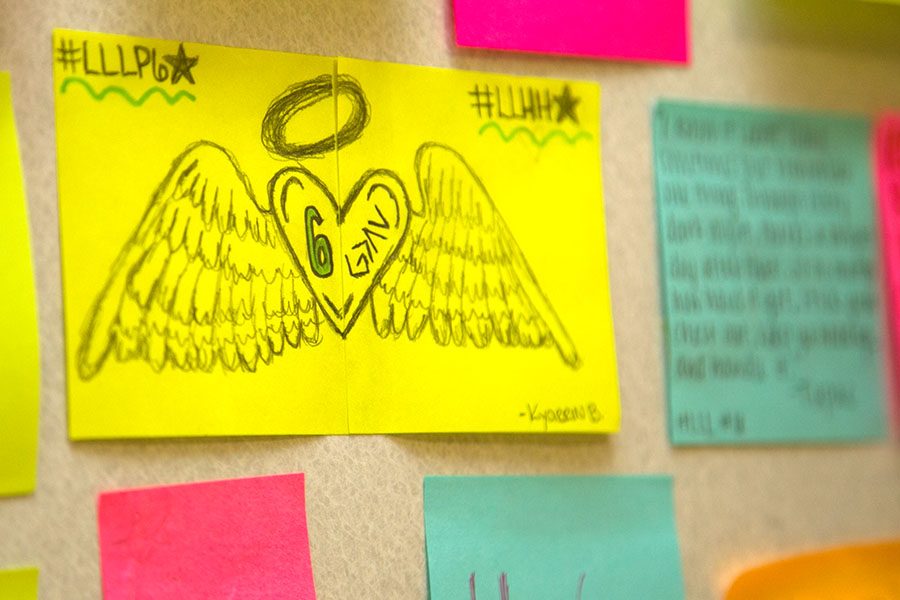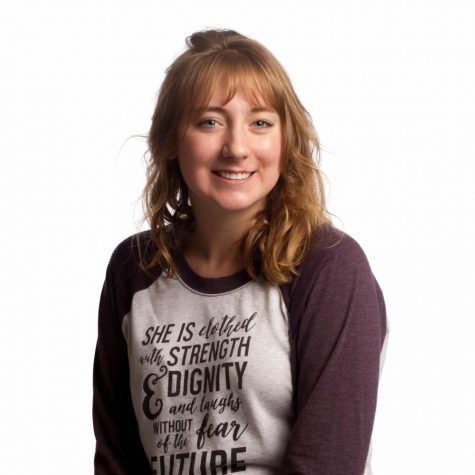All things work for good
Photo by Racheal Sizemore
Positive Post-It Notes line the walls of the English hallway as a way to show support to the student body.
September 12, 2017
Lining the halls are small scraps of brightly colored paper with words scrawled on them. They are plastered to the surface, with the intention of transformation. The words, written in faded pencil, voice the opinion of many; something has to change. Even if it takes one word. One person. One bystander to see the color that is draining from Texas High. One person to come back, and smother the monochromatic halls in vivid hues that speak of encouragement and support.
Michele Ridgon, an english teacher, began passing out sticky notes and pens to her classes, and encouraged them to write one positive thing, and then to post it outside on the wall. The wall, located in hall three, is now known as “Be the Light,” and it was meant to comfort people after the tragedies that have occurred.
“Well it all started with the news that everybody got late on Saturday night. I came in that Sunday, and I felt the weight of the circumstances myself,” Rigdon said. “I had Leonard’s folder here, and I was trying to figure a way for us to implement something in a time where everybody knew what the mood would be on the next day.”
Leonard Parks was formerly in Rigdon’s english class. At the time, they were studying classic poetry, and doing writing exercises.
“We were studying ‘Beowulf,’ and usually later, I will ask the question ‘What is a hero?’ and ‘What traits does any hero typically have?’ and then, ‘Who would you look to as a hero in your own life?’ and explain why. I posted those three questions, and asked them to answer what comes to your mind, and said ‘we’ll come back to it,’” Rigdon said. “And so he wrote: ‘To me a hero is someone that does something out of the normal, I think the hero is me.’ He wrote this, and he talked about ‘Superman.’ He said ‘He’s my favorite, he reminds me of myself in some way.’ So then I said ‘Okay now pick your strongest line, the line that means the most to you, and underline it, and put it on the back.’ And he said ‘I think I am the hero, in the sense that I am a rescuer.’”
Rigdon continued her class the next day with introducing the characters in a hands-on way; however, she found it incredible that Parks would unknowingly choose to be the rescuer.
“The next day, we introduced the characters, and that day everybody comes in and picks a character randomly, they sort of gravitate toward the costume. You become the person that you put on,” Rigdon said. “Beowulf is a story about an epic hero, and as he gets older he still has that heart of a warrior. He’s too old to fight the battle by himself. The character who helps him, his name is Wiglaf, he becomes the next epic hero. Well that day, I realized that was the character he chose, that he is the rescuer to Beowulf. So [Leonard] didn’t know that. We hadn’t even studied that. He just put that on.”
Following the circumstances of Park’s passing, Rigdon began brainstorming of possible ways to lift the spirits of her students. She undoubtedly knew that with everything that had recently happened, the students needed to know that they were loved, and that they were valued.
“So I’m looking for how we can tie together what he represented in the moments, you know, what were his attributes, what exemplifies him, now that he’s not there in that seat. If you have a legacy to leave, what are the attributes you leave behind? What do we remember about him, the light in his existence, what can we take from this that can lead us forward in a way so he isn’t lost?,” Rigdon said. “He said that’s what he wanted to be known as. There’s something to be said for that, and we can pull from that. We needed a rescuer; we needed to be rescued in the moments after the week that we had. There is a message there.”
Despite the smothering sadness that seemed to seep through everything, Rigdon refused to let it overwhelm her, or her classroom.
“There had to be a way to find the positive, or find a way to turn it around, because you can either stay in the dark, or you can look to do something positive,” Rigdon said. “It all placed itself where it needed to be. I decided to use all of the positive traits that people embody that we remember them for. He was patient. He was funny. We need to learn that if this is the last day that we had, what are we leaving? I think that he exemplified that, in the things that he had, and the message that we have with him, how do we push through the darkness of his loss and then make it worth something. And so that’s how the ‘be the light’ started. It came from that.”
Although Rigdon intended her supplies to be used for writing lengthy essays, it seems there was another purpose meant for those vibrant sheets of paper.
“That paper and those sticky notes, I bought with my own money with the intent of using it for writing in this class, because this is Comp. I,” Rigdon said. “You know sometimes the lined page can be oppressive, so I thought ‘oh we can buy those post it notes, we could start on those.’ But now I realize that there was a greater purpose for me to purchase those things.”
She hopes that what started as a simple act of bravery, will turn into a mark of kindness, and that students will continue to pass on compassion to one another.
“I hope that the whole wall spreads. The whole mood just changed, that whole week. People walked in, just different, kinder, conscientious of the person sitting next to them,” Rigdon said. “That wall is so positive, just the messages, the things that people had to say. Even when you’re feeling overwhelmed with something, you can just look at something like that, and know that someone cared enough to put it there. It’s just generating positivity.”
All it takes is one person to stand up and voice their thoughts for change to happen, and when students and teachers alike begin to collaborate to create something beautiful, generosity and hope will persevere.
“I am just proud of how people joined together. I think that proves that when people have a common goal they can change things,” Rigdon said. “And what a difference it made in this situation, where we all could have continued to move in the darkness of the moment, and we didn’t. And it made a difference.”
Park’s death will not be forgotten, nor ignored. He is a lasting testimony to the community that life is short, and acutely fragile. He is a reminder that life is too precious to waste, too significant to focus on what a person may be lacking.
“You can feel it. It’s a different mood. People seem to be more aware of people they have never spoken to before, seem to be including more people, and that is so essential, and if we take nothing away, I hope that people remember that,” Rigdon said. “And if they do, you know, he’s rescuing us. If he rescues us as a community, through what we have learned through this loss, then we all become better people, and it is a legacy. I think he will. You know he said ‘I am the hero,’ and we all need to be the hero for someone else that needs it.”
Rigdon thoroughly believes that everything that happens, either good or bad, has the power to impact someone or something. She believes that people are given a choice in any situation, and that the choice to choose the light is always there. Although it is a high, narrow road, it is the road that is worth all the pain and suffering.
“All things work together for good. Patience, kindness and joy. We all have those things, and they’re free to give,” Rigdon said. “That is what bolsters humanity. We can choose the darkness, or we can choose the light.”


















Irving Berlin • Nov 21, 2017 at 10:24 pm
I love it!
Rene Smith • Sep 14, 2017 at 8:13 am
Michele Rigdon is a master teacher and a fine human being. She truly cares about young people and about the world around us all. She dedicates her tireless efforts in the classroom to not just teaching the classics, but teaching teenagers how to become classic themselves. She cares about their hearts as well as their minds. Students see that she’s real, and they respond in a real way. I’m proud to have taught with her, and I’m grateful for her friendship. She inspires me to be a better human being, and she renews my faith in mankind.
Kristen • Sep 13, 2017 at 6:20 am
Beautifully written story. Moving account of kindness and love being lived and spread to others.